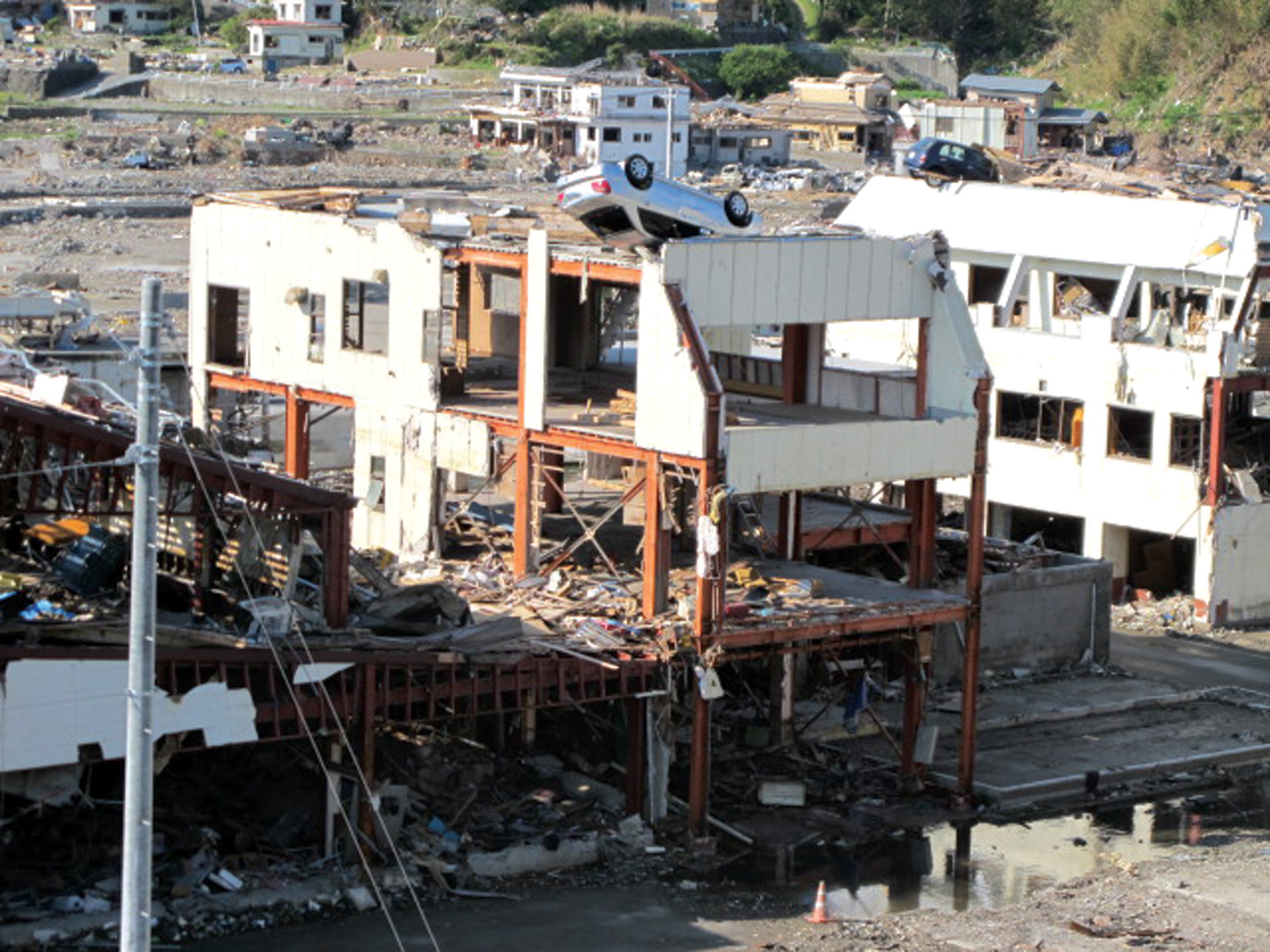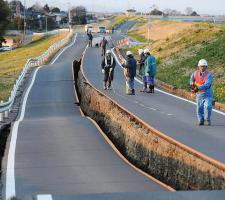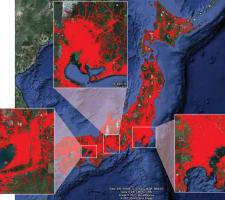
The March 2011 tsunami caused nearly 16,000 deaths and almost 27,000 injuries, as well as economic damage estimated at US$235Bn
A new vehicle routeing initiative has arisen to help improve emergency response and relief following natural disasters in Japan. David Crawford reports
Japan’s national ITS groupA new, robust traffic information platform using probe data obtained from vehicles to support traffic flow will build on the shared experience of major players gained in recent catastrophes.
The March 2012 announcement saw the birth of a formal collaboration between ITS Japan; car manufacturers
ITS Japan, formed in 1994 as the Vehicle, Road & Traffic Intelligence Society (VERTIS) and renamed in June 2001, plays an active role in promoting ITS research, development and deployment. It is supported by four Japanese government departments: the National Police Agency; the Ministry of Land, Infrastructure & Transport; the Ministry of Public Management, Home Affairs, Posts & Telecommunications, and the Ministry of Economy, Trade & Industry.
The set up therefore represents a close alliance of public and private sector actors. It will build a system based more on information sourced from vehicles – private, public and commercial – in the form of automatic probe data from in-vehicle navigation systems and drivers’ mobile phones and navigation smartphones. This will be instead of information gleaned mainly from road operators and traffic police centres.
In the process, a central disaster response role will be created for in-vehicle telematics, bringing in automotive manufacturers as key players. Increasing numbers of equipped vehicles are now reaching the market, with rising numbers of electric vehicles contributing to the trend.
The output will be a series of online traffic road maps based on the integration of information derived from the carmakers’ members-only services, with that from other sources. These online maps will be designed to enable quick decision making by highlighting accessible roads in blue and inaccessible routes in red. ITS Japan also plans to create a system of rapid information for government bodies, including the Fire & Disaster Management Agency and local administrations, by delivering timely map updates to support the routeing of emergency recovery and rescue activities.
Natural disasters
The initiative follows hard on the heels of a series of disasters that have hit Japan over recent years – the worst of these being the March 2011 undersea earthquake and resulting tsunami that struck a 500km stretch of the east coast of the main Japanese island of Honshu. This event caused nearly 16,000 deaths and almost 27,000 injuries, as well as economic damage estimated by the World Bank at US$235Bn – making this the most expensive natural disaster in the history of the world to date.The tsunami, in turn, caused a series of accidents at the Fukushima Daiichi nuclear power plant complex, cutting off electric power supplies and creating a 20km radius evacuation zone.
These events and their aftermaths caused chaotic conditions for the movement of people and goods, resulting from disruption of damaged road networks in the areas directly affected and congestion in areas being used by rescue and emergency relief activities.
A major contributing factor was that swathes of road infrastructure-based traffic information and management systems were also badly affected. Wide-area power outages meant that sensors, traffic signals, variable message signs and cameras could not work if they did not have independent back up power.
In a commendably rapid bid to mitigate the situation, ITS Japan worked with its partners to make accessible a first version of the projected disaster response traffic road map and this became available for use within days of the crisis occurring. The collaboration made it possible to open up the benefits of in-vehicle probe and mobile phone location data for the disaster hit region and so enable the correct mapping of accessible routes.
The partnership collected the map data from the companies’ members on an anonymous basis, in the same way as for their standard navigation systems. To enhance the speed of data collection in support of the ongoing emergency response, ITS Japan took on the role of management and integration of the information collected prior to its distribution.
This collaboration marked the first time in the history of Japan’s ITS industry that traffic information from four different sources was integrated at a single point. ITS Japan continued updating the road map on a daily basis. It also encouraged freight operators to make use of the information in planning their deliveries of relief supplies. This was in pursuit of a long term aim of aiding more efficient logistics to accelerate disaster recovery.
Gaps in coverage
The operation highlighted some serious gaps in existing emergency information coverage. On the first detection of the earthquake, for example, the country’s established Vehicle Information & Communication System (VICS) and ITS Spot information service automatically sent out an emergency message to car navigation systems; but an alarm message for a tsunami was not included in the list of automated responses.Another ‘area mail’ service for dispatching emergency messages for mobile phone users also worked for earthquakes – but again, not for the tsunami owing to a lack of the necessary operational procedures: a key lesson learnt and being incorporated into the current collaboration. Overall, while the initiative and the speed of its introduction were recognised as being commendable, awareness of its potential was not widespread.
A reminder of the need for continuing work in this area came in September 2011, when the central part of the country was hit by typhoons that brought heavy rains, widespread floods, road damage and power cuts. This created a further opportunity – specifically to add in probe data from heavy trucks – while further underlining the need to develop and publicise standardised operational procedures. This would build on the robustness of wireless, mobile technology information systems with their wide geographical spread and growing number of data points independent of infrastructure.
There are limitations of course – at least at present. One is that the quality of vehicle probe data is dependent on the size of the sample – particularly if data from fixed sensors is not available to complement it. This data tends to be more reliable than that coming from mobile phones; where there are uncertainties as to which transport mode a person is using; and whether he or she is standing on the pavement or is inside a stationary vehicle. Again, however, technologies are emerging to distinguish the transport mode from speed and patterns of acceleration and deceleration.
Added urgency
Adding to the urgency of the new initiative are the present predictions of the 70% probability of a quake centred on the north of Tokyo Bay at some point within the next three decades. A report issued in March 2012 by the country’s Ministry of Education, Culture, Sports, Science & Technology suggests that the impact could be more serious than was previously calculated, uprating earlier estimates of 11,000 dead and 850,000 buildings destroyed.A further Cabinet Office report, published in April 2012, indicates that the country’s present array of embankments would be unable to contain a massive tsunami. There are, therefore, future prospects of widespread flood damage.
Once the new platform is established, the plan is that the existing VICS and ITS Spot systems will become part of it. VICS went live in 1996 as an early example of the use of the cooperative vehicle infrastructure system to provide real-time traffic information and alerts to in-vehicle navigation systems with the dual aims of increasing safety and reducing congestion. It is essentially a vehicle-to-infrastructure (V2I) system delivering information via a variety of media.
Since VICS information became available to the private sector in 2002, Toyota, Nissan and Honda have all used it to provide real-time traffic information services to their customers. Specifically, probe vehicle information is being used to offer customers routeing information; Honda started such a service in 2003, and Nissan and Toyota followed in 2007













